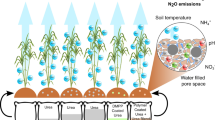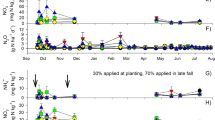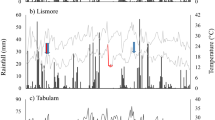Abstract
Nitrogen fertilizer practices affect nitrous oxide (N2O) emissions from agricultural soils. The “4R” nutrient stewardship framework of using N fertilizer at the right rate, right source, right placement and right time can reduce N2O emissions while maintaining or improving yield of field crops, but understanding of how the various factors affect N2O emissions from irrigated processing potato is lacking. We examined the effects of selected 4R practices on emissions, using results from two irrigated processing potato studies each conducted in 2011 and 2012 in Manitoba, Canada. Experiment 1 examined combinations of source (urea, ESN), placement (pre-plant incorporation [PPI], banding), and rate (100 and 200 kg N ha-1) on a clay loam soil. Experiment 2 examined timing and source treatment combinations (urea PPI, ESN PPI, urea split, urea split/fertigation) on a loamy fine sandy soil. For Experiment 1, use of ESN at 200 kg ha-1 did not reduce area-, yield- and applied fertilizer N- based N2O emissions compared to urea at 200 kg ha-1, irrespective of placement. Emissions from pre-plant banding ESN at 200 kg ha−1, however, were 32% lower than from PPI ESN. For Experiment 2, compared to single pre-plant urea application, fertigation simulated by in-season application of urea ammonium nitrate (UAN) gave lower area-, yield- and applied fertilizer N- based emissions. Split urea ( \( \raisebox{1ex}{$2$}\!\left/ \!\raisebox{-1ex}{$3$}\right. \) pre-plant, \( \raisebox{1ex}{$1$}\!\left/ \!\raisebox{-1ex}{$3$}\right. \) hilling) also reduced area- and yield- based N2O emissions compared to single pre-plant urea application. Emissions were generally lower at the site with loamy fine sandy soil than the site with clay loam soil. These results demonstrate that combinations of “4R” practices rather than source alone are best to achieve reductions in N2O emissions from irrigated potato production.
Resumen
Las prácticas de fertilización nitrogenada afectan las emisiones de óxido nitroso N2O de los suelos agrícolas. El marco de referencia administrativo de nutrientes “4R” del uso de fertilizante nitrogenado a nivel, fuente, ubicación y tiempo correctos, puede reducir las emisiones de N2O mientras se mantiene o se mejora el rendimiento de los cultivos en el campo, pero se carece del entendimiento de como varios factores afectan dichas emisiones en papa para proceso bajo riego. Examinamos los efectos de prácticas selectas 4R en emisiones, utilizando los resultados de dos estudios de papa de riego para proceso conducidos en 2011 y 2012 en Manitoba, Canadá. En el experimento 1 se examinaron las combinaciones de fuente (urea, ESN), colocación (incorporación pre-siembra [PPI], en bandas), y cantidad (100 y 200 kg N ha-1), en un suelo franco-arcilloso. En el experimento 2 se examinó la combinación de tratamientos de tiempo y fuente (urea, PPI, ESN PPI, urea fraccionada, urea fraccionada/riego) en un suelo fino franco-arenoso. Para el experimento 1, el uso de ESN a 200 kg ha-1, no redujo el área-rendimiento, ni las emisiones de N2O con base a la aplicación del fertilizante nitrogenado comparado con la urea a 200 kg ha-1 independientemente de la colocación. Las emisiones de ESN pre-siembra en banda a 200 kg ha-1, no obstante, fueron 32% más bajas que las de PPI ESN. Para el experimento 2, en comparación a la aplicación de urea simple en pre-siembra, la fertirrigación simulada por la aplicación durante el ciclo de urea nitrato de amonio (UAN) dio más bajo rendimiento-área y de emisiones basadas en la aplicación de fertilizante nitrogenado. La urea fraccionada ( \( \raisebox{1ex}{$2$}\!\left/ \!\raisebox{-1ex}{$3$}\right. \) pre-siembra, \( \raisebox{1ex}{$1$}\!\left/ \!\raisebox{-1ex}{$3$}\right. \) al aporque), también redujo área-rendimiento con base a las emisiones de N2O en comparación con la aplicación única de urea pre-siembra. Las emisiones fueron generalmente más bajas en el sitio con suelo fino franco-arenoso que en el de suelo franco-arcilloso. Estos resultados demuestran que las combinaciones de las prácticas “4R” en vez de la fuente solamente, son mejores para lograr reducciones en las emisiones de N2O en la producción de papa de riego.





Similar content being viewed by others
Abbreviations
- DOY:
-
day of year
- EF:
-
N2O emission factor
- EI:
-
N2O emission intensity
- PPI:
-
pre-plant incorporation
- ∑N2O:
-
growing season area-scaled cumulative emissions
References
Abalos, D., L. Sanchez-Martin, L. Garcia-Torres, J.W. van Groenigen, and A. Vallejo. 2014. Management of irrigation frequency and nitrogen fertilization to mitigate GHG and NO emissions from drip-fertigated crops. Science of Total Environment 490: 880–888.
Asadi, M.E., R.S. Clemente, A.D. Gupta, R. Loof, and G.K. Hansen. 2002. Impacts of fertigation via sprinkler irrigation on nitrate leaching and corn yield in an acid-sulphate soil in Thailand. Agricultural Water Management 52: 197–213.
Asgedom, H., M. Tenuta, D.N. Flaten, X. Gao, and E. Kebreab. 2014. Nitrous oxide emissions from a clay soil receiving granular urea formulations and dairy manure. Agronomy Journal 106: 732–744.
Bouwman, A.F., L.J.M. Boumans, and N.H. Batjes. 2002. Emissions of N2O and NO from fertilised fields: summary of available measurement data. Global Biogeochemical Cycles 16: 1058.
Burton, D.L., X. Li, and C.A. Grant. 2008a. Influence of fertilizer nitrogen source and management practice on N2O emissions from two black chernozemic soils. Canadian Journal of Soil Science 88: 219–227.
Burton, D.L., B.J. Zebarth, K.M. Gillarn, and J.A. MacLeod. 2008b. Effect of split application of fertilizer nitrogen on N2O emissions from potatoes. Canadian Journal of Soil Science 88: 229–239.
Chantigny, M.H., P. Rochette, D.A. Angers, S. Bittman, K. Buckley, D. Massé, G. Bélanger, N. Eriksen-Hamel, and M.O. Gasser. 2010. Soil nitrous oxide emissions following band-incorporation of fertilizer nitrogen and swine manure. Journal of Environmental Quality 39: 1545–1553.
Ciarlo, E., M. Conti, N. Bartoloni, and G. Rubio. 2008. Soil N2O emissions and N2O/(N2O+N2) ratio as affected by different fertilization practices and soil moisture. Biology and Fertility of Soils 44: 991–995.
Darwish, T.M., T.W. Atallah, S. Hajhasan, and A. Haidar. 2006. Nitrogen and water use efficiency of fertigated processing potato. Agricultural Water Management 85: 95–104.
Gao, X., M. Tenuta, A. Nelson, B. Sparling, D. Tomasiewicz, R.M. Mohr, and B. Bizimungu. 2013. Effect of nitrogen fertilizer rate on nitrous oxide emission from irrigated potato on a clay loam soil in Manitoba. Canadian Journal of Soil Science 93: 1–11.
Gao, X., H. Asgedom, M. Tenuta, and D.N. Flaten. 2015. Enhanced efficiency urea sources and placement effects on nitrous oxide emissions. Agronomy Journal 107: 265–277.
Granli, T., and O.C. Bøckman. 1994. Nitrous oxide from agriculture. Norwegian Journal of Agricultural Sciences (Supplement) 12: 1–128.
Grant, C.A., and R. Wu. 2008. Enhanced-efficiency fertilizers for use on the Canadian prairies. Crop Management: 1–15. doi:10.1094/CM-2008-0730-01-RV.
Hagin, J., and A. Lowengart. 1996. Fertigation for minimizing environmental pollution by fertilizers. Fertilizer Research 43: 5–7.
Halvorson, A.D., and S.J. Del Grosso. 2013. Nitrogen placement and source effects on nitrous oxide emissions and yields of irrigated corn. Journal of Environmental Quality 42: 312–322.
Halvorson, A.D., C.S. Snyder, A.D. Blaylock, and S.J. Del Grosso. 2014. Enhanced-efficiency nitrogen fertilizers: potential role in nitrous oxide emission mitigation. Agronomy Journal 106: 715–722.
Hannah, W. 2015. Nitrogen and irrigation management to reduce nitrous oxide emissions in corn systems. Master thesis, University of California, Davis. ISBN: 9781339543277.
Hyatt, C.R., R.T. Venterea, C.J. Rosen, M. McNearney, M.L. Wilson, and M.S. Dolan. 2010. Polymer-coated urea maintains potato yields and reduces nitrous oxide emissions in a Minnesota loamy sand. Soil Science Society of America Journal 74: 419–428.
IPCC. 2006. Intergovernmental panel on climate change guidelines for national greenhouse gas inventories. Volume 4: agriculture, forestry and other land use. Chapter 11: N2O emissions from managed soils, and CO2 emissions from lime and urea application.
Kelling, K.A., R.F. Hensler, and P.E. Speth. 2015. Importance of early-season nitrogen rate and placement to russet Burbank potatoes. American Journal of Potato Research 92: 502–510.
Kennedy, T.L., E.C. Suddick, and J. Six. 2013. Reduced nitrous oxide emissions and increased yields in California tomato cropping systems under drip irrigation and fertigation. Agriculture, Ecosystems and Environment 170: 16–27.
Li, C., X. Hao, R.E. Blackshaw, J.T. O’Donovan, K.N. Harker, and G.W. Clayton. 2012. Nitrous oxide emissions in response to ESN and urea, herbicide management and canola cultivar in a no-till cropping system. Soil Tilliage Research 118: 97–106.
Maharjan, B., and R.T. Venterea. 2013. Nitrite intensity explains N management effects on N2O emissions in maize. Soil Biology & Biochemistry 66: 229–238.
Manitoba Soil Fertility Guide. 2007. [online] http://www.gov.mb.ca/agriculture/crops/soil-fertility/soil-fertility-guide/pubs/soil_fertility_guide.pdf.
Mills, G. F. and P. Haluschak. 1995. Soils of the Manitoba crop diversification center. Special Report 95–1. Manitoba Soil Resource, Winnipeg
Nash, P.R., P.P. Motavalli, and K.A. Nelson. 2012. Nitrous oxide emissions from claypan soils due to nitrogen fertilizer source and tillage/fertilizer placement practices. Soil Science Society of America Journal 76: 983–993.
Pedersen, A.R. 2011. HMR: flux estimation with static chamber data. R package version (3): 1 http://Cran.R-Project.Org/Package=HMR.
Pelster, D.E., M.H. Chantigny, P. Rochette, D.A. Angers, C. Rieux, and A. Vanasse. 2012. Nitrous oxide emissions respond differently to mineral and organic nitrogen sources in contrasting soil types. Journal of Environmental Quality 41: 427–435.
Prince Edward Island Government. 2014. Potato Fertilization. [online] http://www.gov.pe.ca/photos/original/af_fact_potfer.pdf. Accessed 26 Sept 2016.
Ruser, R., H. Flessa, R. Schilling, F. Beese, and J.C. Munch. 2001. Effect of crop-specific field management and N fertilization on N2O emissions from a fine-loamy soil. Nutrient Cycling in Agroecosystems 59: 177–191.
SAS Institute. 2011. SAS for Windows. Release 9.3. SAS Inst. Inc., Cary.
Smith, K.A., I.P. McTaggart, K.E. Dobbie, and F. Conen. 1998. Emissions of N2O from Scottish agricultural soils, as a function of fertilizer N. Nutrient Cycling in Agroecosystems 52: 123–130.
Snyder, C.S., T.W. Bruulsema, T.L. Jensen, and P.E. Fixen. 2009. Review of greenhouse gas emissions from crop production systems and fertilizer management effects. Agriculture, Ecosystems and Environment 133: 247–266.
Statistics Canada. (2016). CANSIM (database). Table 001–0014: area production and farm value of potatoes. http://www5.statcan.gc.ca/cansim/a26?lang=eng&id=10014#customizeTab. Accessed 20 Nov 2016.
Tenuta, M., X. Gao, D.N. Flaten, and D.A. Brian. 2016. Lower nitrous oxide emissions from anhydrous ammonia application prior to soil freezing in late fall than spring pre-plant application. Journal of Environmental Quality 45: 1133–1143.
Trenkel, M.E. 2010. Slow- and controlled-release and stabilized fertilizers: an option for enhancing nutrient use efficiency in agriculture. Paris: International Fertilizer Industry Association.
Vallejo, A., U.M. Skiba, L. Garcia-Torres, A. Arce, S. Lopez-Fernandez, and L. Sanchez-Martin. 2006. Nitrogen oxide emissions from soils bearing a potato crop as influenced by fertilization with treated pig slurries and composts. Soil Biology & Biochemistry 38: 2782–2793.
Venterea, R.T., M. Bijesh, and M.S. Dolan. 2011. Fertilizer source and tillage effects on yield-scaled nitrous oxide emissions in a corn cropping system. Journal of Environmental Quality 40: 1521–1531.
Venterea, R.T., J.A. Coulter, and M.S. Dolan. 2016. Evaluation of intensive “4R” strategies for decreasing nitrous oxide emissions and nitrogen surplus in rainfed corn. Journal of Environmental Quality 45: 1186–1195.
Weier, K.L. 1999. N2O and CH4 emission and CH4 consumption in a sugarcane soil after variation in nitrogen and water application. Soil Biology & Biochemistry 31: 1931–1941.
Westermann, D.T., and R.E. Sojka. 1996. Tillage and nitrogen placement effects on nutrient uptake by potato. Soil Science Society of American Journal 60: 1448–1453.
Yan, X., Y. Hosen, and K. Yagi. 2001. Nitrous oxide and nitric oxide emissions from maize field plots as affected by N fertilizer type and application method. Biology and Fertility of Soils 34: 297–303.
Zebarth, B.J., and P.H. Milburn. 2003. Spatial and temporal distribution of soil inorganic nitrogen concentration in potato hills. Canadian Journal of Soil Science 83: 183–195.
Zebarth, B.J., E. Snowdon, D.L. Burton, C. Goyer, and R. Dowbenko. 2012. Controlled release fertilizer product effects on potato crop response and nitrous oxide emissions under rain-fed production on a medium-textured soil. Canadian Journal of Soil Science 92: 759–769.
Acknowledgement
Greenhouse gas emission monitoring in this study was funded by the Agricultural Greenhouse Gas Program (AGGP) of Agriculture and Agri-Food Canada (AAFC), a contract to Dr. Tenuta for the project “Determination of Greenhouse Gas Release from an Irrigated Field Research Trial in Manitoba” AAFC file number 3000479448, Agrium Inc., the Canada Research Chair Program in Applied Soil Ecology (Tenuta), and the National Sciences and Engineering Council of Canada (NSERC) Discovery Grant Program (Tenuta). Additionally, we thank Brad Sparling for gas analyses and staff of CMCDC-Carberry for assistance with plot establishment and gas sampling.
Author information
Authors and Affiliations
Corresponding author
Rights and permissions
About this article
Cite this article
Gao, X., Parsonage, S., Tenuta, M. et al. Nitrogen Fertilizer Management Practices to Reduce N2O Emissions from Irrigated Processing Potato in Manitoba. Am. J. Potato Res. 94, 390–402 (2017). https://doi.org/10.1007/s12230-017-9574-4
Published:
Issue Date:
DOI: https://doi.org/10.1007/s12230-017-9574-4




